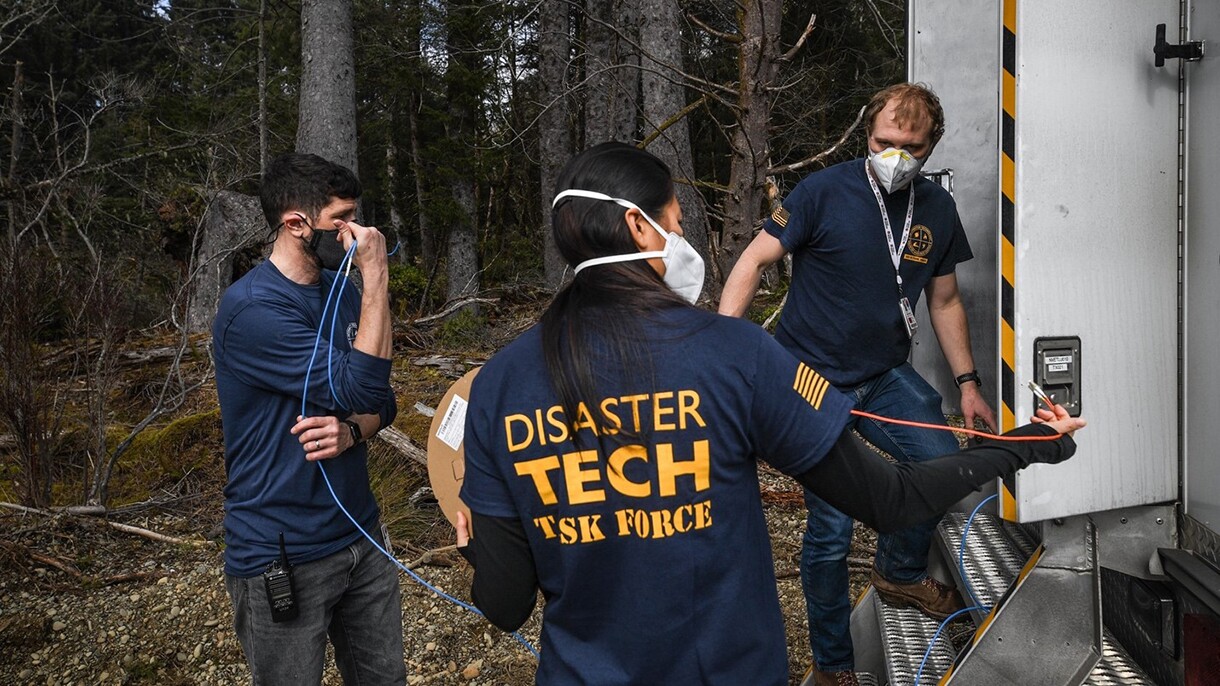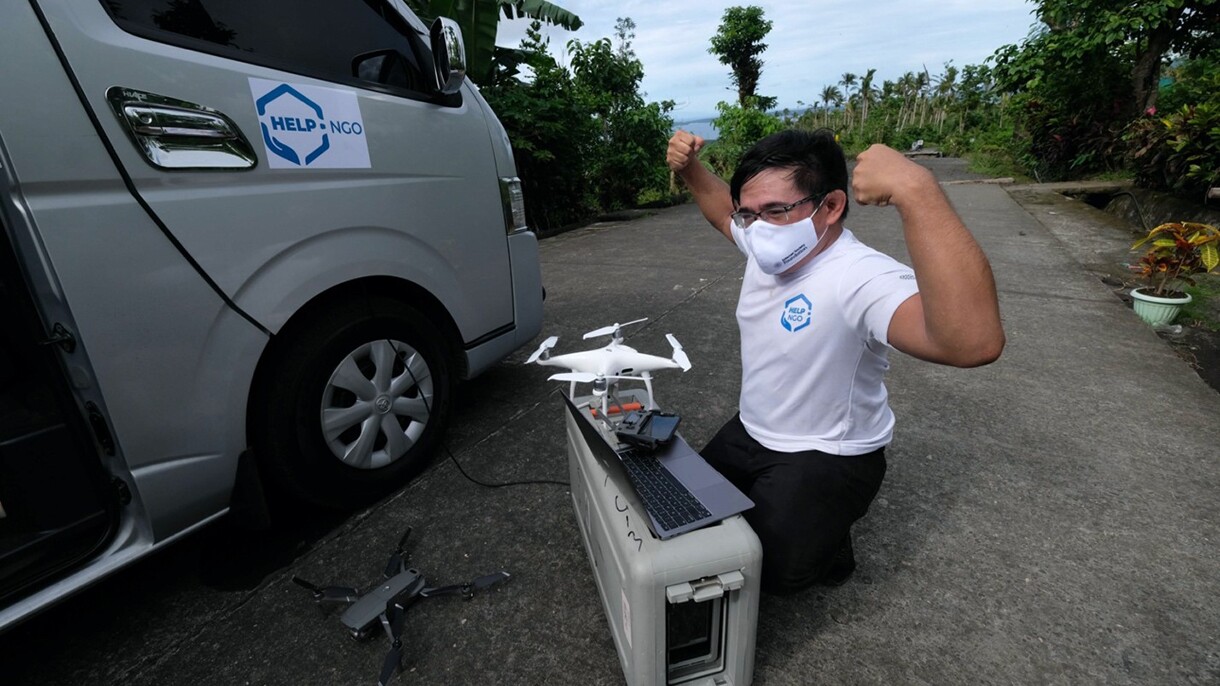When natural disasters strike, those of us outside the destructive path of hurricanes, wildfires, floods—or whatever calamity has arrived—often witness the impact through images of people lining up for food, water, and shelter.
What we don’t see is something just as vital to people in the midst of disaster: data and connectivity. Getting a network back up and running enables people to reach out to loved ones and helps relief groups quickly collect and analyze data, so those human essentials—food, water, and shelter—can be distributed more efficiently, safely, and equitably to people who need them.
"The notion of people asking for a Wi-Fi connection and a phone charger before they ask for water is 100% true," said Brendan Harvey, executive director of Help.NGO and a member of the organization's Disaster Immediate Response Team (DIRT). "And it’s not just the ability of those stricken by some disaster to communicate. It’s also the ability of responders to communicate with the people and communities they are there to help, and the ability of responders to communicate with each other."
As the severity and frequency of natural disasters increase worldwide, Harvey's organization and other tech experts, including the Amazon Web Services (AWS) Disaster Response team and its volunteers, have become invaluable. In late 2020, for example, teams traveled to the Philippines to help find suitable land for shelters—using drone footage and other technology—after about 390,000 people were displaced by a cyclone.
Our program was founded on the belief that technology has the power to solve the world’s most pressing issues.
Noah Eden
global lead of AWS Disaster ResponseThis year could be just as busy. June 1 is the official start of the 2021 Atlantic hurricane season for the southeast U.S., the Caribbean, and the Gulf Coast. However, the season’s first named storm, Tropical Storm Ana, began developing on May 22—extending a six-year streak of storms forming early.
The 2020 hurricane season saw so many storms—30 in all—that the UN World Meteorological Organization, which names storms, ran out of prepared names and resorted to the Greek alphabet. The National Oceanic and Atmospheric Administration said “an above-normal season is most likely” in 2021.
This pattern isn't unique to the region—or just to hurricanes. Across the globe, the severity and frequency of wildfires, floods, severe storms, and other natural disasters has increased, as have the human and financial costs. To help minimize those costs, access to data has become essential for people in need of help and those offering it.
The AWS Disaster Response program has a roster of volunteers on standby to provide support during disasters. The employees are required to take FEMA and Red Cross training before deploying to support nonprofit partners, such as Help.NGO and the Information Technology Disaster Resource Center (ITDRC). The support may include lending technical expertise to restore connectivity on the ground. The volunteers also help customers leverage edge services to access critical data locally.
 AWS Disaster Response lead Noah Eden (left) and senior program manager Cassandra Fong (center) work with ITDRC.Photo by ITDRC Photographer, Hannah Ridings
AWS Disaster Response lead Noah Eden (left) and senior program manager Cassandra Fong (center) work with ITDRC.Photo by ITDRC Photographer, Hannah RidingsITDRC is an organization of about 2,500 volunteers, primarily across the U.S., whose mission is to connect communities in crisis. ITDRC was co-founded by Joe Hillis, a veteran public safety official technologist. He and his team work with a cross-section of tech companies, including the AWS Disaster Response team, to show up at a disaster scene with generators, satellite dishes, Wi-Fi repeaters, and miles of cable. When power is out and cellphone coverage is zero, ITDRC volunteers work to establish temporary, local connectivity while telecommunications and utility companies are busy repairing permanent infrastructure.
"It’s vital during these events to be able tell people, 'I’m OK, I’m at the shelter,' or at the church or the relatives', but 'I am OK,'" said Hillis, head of operations at ITDRC. "It helps the mental health of the community. If you can say, 'I’m OK,' it starts the healing process."
Emergency responders can tap the ITDRC network to put out a call for needed supplies or to direct supplies where they are most helpful. Using an AWS Snowball Edge device, a portable, ruggedized box that offers the ability to collect, store, and quickly process data almost anywhere, ITDRC volunteers have stood up remote video conferencing, and connected agencies together so they can coordinate response and resources as efficiently as possible. They've also done things as simple as connecting a screen to stream cartoons for kids huddled in a shelter.
"It gives them a feeling of safety and normalcy," Hillis said. "It’s all about starting that healing, and in that sense, we bring hope as much as we bring infrastructure.”
"Not so long ago, providing immediate data connectivity in some parts of the world during and after a natural disaster was not a priority," said Harvey, executive director at Help.NGO. “But we live in an interconnected world increasingly mediated by the internet and informed by data, and that has become especially true in the context of emergency response and what happens in the aftermath," he said.
Faster connectivity, more data, and subsequent data analysis helps the organizations quickly get food, supplies, and other essentials to people who need it most.
"Our program was founded on the belief that technology has the power to solve the world’s most pressing issues," said Noah Eden, global lead of AWS Disaster Response. "AWS is uniquely positioned to support nonprofits, disaster response organizations, and communities in their time of greatest need. By combining a spirit of volunteerism with cutting edge technology, we can act as a force multiplier for organizations responding to disasters while helping them overcome the unique challenges they face in the field."
If you screw up that data you have to go back, and it's literally another week that people would go without a home.
Adam Marlatt
Help.NGO's operations directorWhen cyclones Idai and Kenneth made landfall in Mozambique in 2019, Help.NGO DIRT deployed to offer mapping and communications support. Accurate maps are critical for first responders to know the pre-storm locations of people and vital infrastructure, and to plan for managing a disaster most efficiently. Idai first struck the southeastern African coast in March 2019 and displaced more than 146,000 people. A month later and 1,000 kilometers north, Kenneth displaced another 20,000 people.
DIRT volunteers, with support from AWS Disaster Response volunteers, used AWS Snowball Edge to store huge volumes of drone imagery they had just collected and make the data available for analysis—all from the back of a van on the side of the road. During Cyclone Idai, that meant being able to direct trucks to passable roads to deliver supplies to communities in need.
"The other option would have been sending out helicopters to deliver supplies," said Adam Marlatt, Help.NGO's operations director. "Not only is that hugely expensive, they can't carry as much as a truck. By being able to validate our drone data, almost in real-time in the back of a van, we knew those roads were passable, and we could put resources where they were needed most."
 Image courtesy of Help.NGO
Image courtesy of Help.NGOTyphoon Goni (known locally as Typhoon Rolly) struck the Philippines on October 28, 2020, with winds peaking at 195 mph. Relocation efforts are still ongoing, and local Philippine DIRT volunteers are on the ground and in the sky with drones to find suitable areas to build shelters for the estimated 390,000 people displaced by the storm.
Shelters need to be a certain size, close to roads, a water source, and other infrastructure. They ground on which the shelters are built must also have a certain slope so water doesn’t pool. Those and other parameters must be analyzed, typically by teams of surveyors, or in the case of DIRT’s local team, by flying drones and analyzing and validating the imagery using the AWS technology in a van on the side of the road.
The ability to validate data in the field is critical. The data includes ensuring safety parameters are correct and that drones are flown in precise spots that agencies have designated as potential shelter areas.
"If you mess up that one flight in the field, it can delay your answer by a week," Marlatt said. "So if you screw up that data you have to go back, and it's literally another week that people would go without a home."
That kind of suffering is exactly what the AWS Disaster Response team, and all the volunteers who lend their brain power and muscle power to the efforts of Help.NGO and ITDRC, are trying to minimize.
Their impact is seen through the simple act of enabling people to let their loved ones know they are safe. It is the creation of higher-resolution pictures of communities, using the data to assess a community’s needs, and collecting more data and applying smarter analysis.
"It's the difference between a blunt instrument and something more surgical,” Harvey said. “Being able to better shift and acutely target assistance in the future by leveraging data in real time is what starts to move us from disaster response, to disaster prevention and risk mitigation."
To contact or learn more about the AWS Disaster Response team, visit https://aws.amazon.com/government-education/nonprofits/disaster-response/
Trending news and stories
- Amazon Pet Day 2025 is coming May 13-14 with 48 hours of deals on pet products and supplies
- LinkedIn names Amazon a top US company where people want to work for the eighth year in a row
- CEO Andy Jassy’s 2024 Letter to Shareholders
- AWS is first major cloud provider to deliver Mistral AI’s Pixtral Large as a fully managed, serverless model








